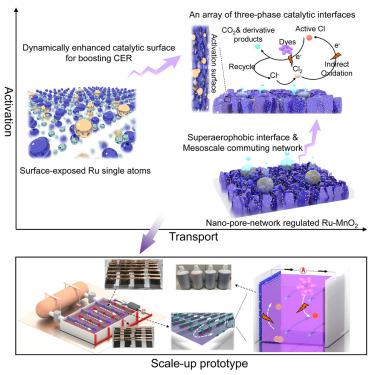Chem Catalysis ( IF 11.5 ) Pub Date : 2023-04-20 , DOI: 10.1016/j.checat.2023.100612 Xiangyang Zhang , Agnes Valencia , Zijun Deng , Jihong Shi , Kelong Ao , Walid A. Daoud

|
Constructing a three-phase interface to balance the multi-scale physicochemical processes is crucial for high-efficiency electrochlorination degradation of organic wastewater, which remains largely underexplored. Herein, we demonstrate a nanopore-network-regulated Ru-MnO2 catalyst embodying an array of three-phase catalytic interfaces for enhancing the activation and transport processes. The key points lie in tailoring accessible surfaces with atomic-scale Ru sites and mesoscale commuting networks for fast species diffusion as well as structure-derived superaerophobic surfaces. The synergy of these features promotes the high generation of Cl2 and subsequently fast departure, facilitating the transition of bubbles from a gas/solid interface into a liquid/solid interface, which availably mitigates the barrier effect, boosts blending of reaction species in wastewater, and yields high degradation efficiency and economic benefits compared with commercial Pt anodes. Furthermore, we envision that the scale-up prototype demonstration will pave the way for large-scale environmental remediation and other aqueous production processes.
中文翻译:

三相界面工程使纺织有机废水降解的电氯化活化和传输成为可能
构建三相界面以平衡多尺度物理化学过程对于有机废水的高效电氯化降解至关重要,这在很大程度上仍未得到充分探索。在此,我们展示了一种纳米孔网络调节的 Ru-MnO 2催化剂,该催化剂包含一系列三相催化界面,用于增强活化和传输过程。关键在于用原子级 Ru 位点和中尺度通勤网络定制可接近的表面,以实现快速物种扩散以及结构衍生的超疏气表面。这些特性的协同作用促进了Cl 2的高生成并随后快速离开,促进气泡从气/固界面过渡到液/固界面,有效减轻屏障效应,促进废水中反应物种的混合,与商业Pt相比具有更高的降解效率和经济效益阳极。此外,我们设想放大原型演示将为大规模环境修复和其他水性生产工艺铺平道路。
















































 京公网安备 11010802027423号
京公网安备 11010802027423号